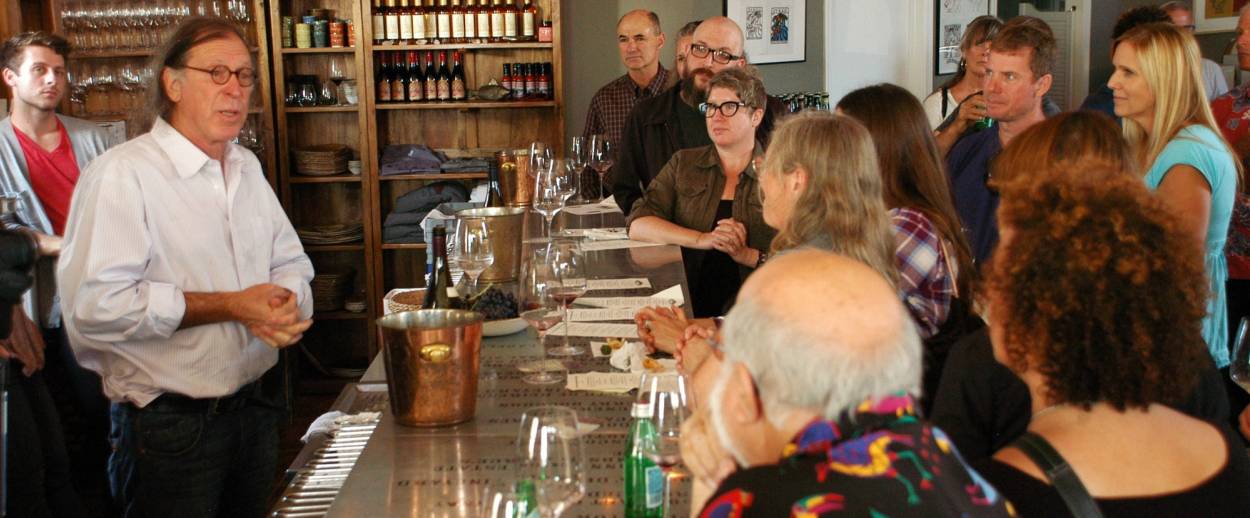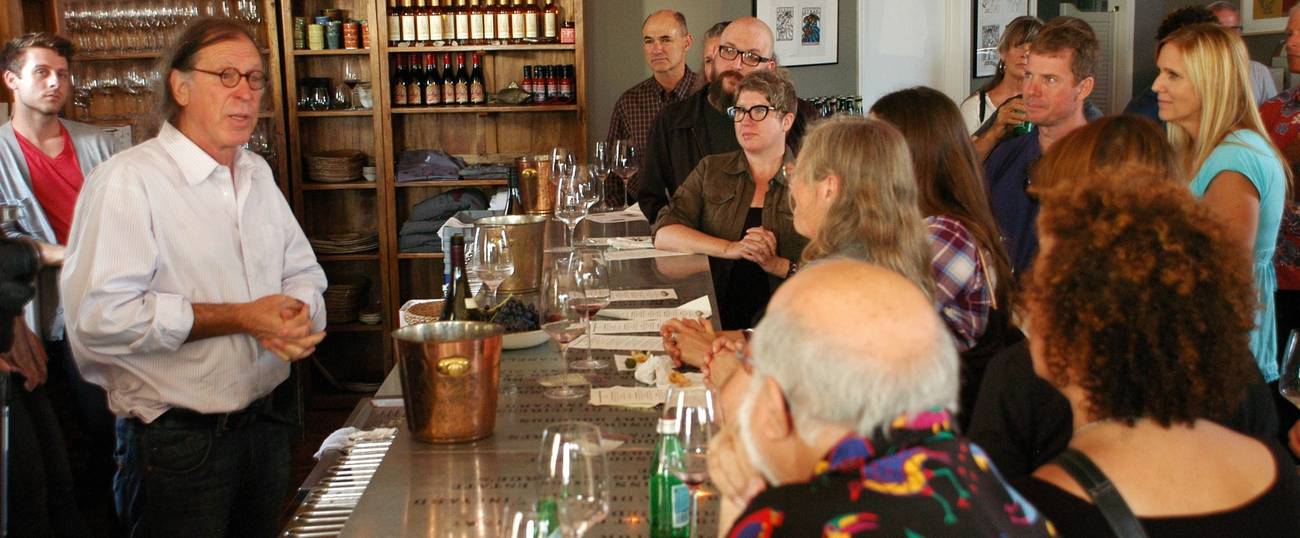On My Father’s Yahrzeit, Remembering Him, One Glass of Wine At a Time
My father loved a lot of things I just don’t get. But sipping an earthy and chocolatey red from his favorite vineyard brought tears to my eyes.




Today, the 26th of Av, is my father’s yahrzeit. He had many cultural obsessions, high and low: Gustav Mahler, Porky’s movies, Werner Herzog, Beavis and Butt-head, Kurt Vonnegut, Eraserhead, Ingmar Bergman, Caddyshack (he put a Baby Ruth in more than one pool) and Bonny Doon wines.
My dad, who died in 2004, was crazy for Bonny Doon. He loved the bottles’ quirky labels and the vintner Randall Grahm’s love of wordplay and mischief. Grahm, a product of the epicenter of literate hippiedom, Santa Cruz, worked during a college break (he was on the ten-year plan, he notes) as a philosopher-stockboy/floor-sweeper at the Wine Merchant store in Beverly Hills. He became fascinated by wine, and returned to school in the late 1970s to get a degree in plant sciences at UC Davis. There, he notes, he was “regarded as a bit of a holy terroir” (hyuk hyuk). With his family’s help, he bought a vineyard (nice work if you can get it), got to work, and in 1989 made the cover of The Wine Spectator, wearing a domino mask and powder-blue polyester riding gear, a wine bottle in a holster at his hip, holding the reins of a white horse. The cover line called him “The Rhône Ranger.” Within a few years an asteroid was named after him, he’d won the James Beard Foundation’s Wine and Spirits Professional of the Year award, and his articles and newsletters had rabid followers—including my father.
Bonny Doon’s first famous wine was Le Cigare Volant—a red with a colorful story, like all of Grahm’s wines. It got its name because back in the 1950s, the mayor of the Rhône Valley town of Châteauneuf-du-Pape became obsessed with reports that cigar-shaped flying saucers had been seen hovering over France. He passed a law banning UFOs, “whatever their nationality,” from flying over or landing in Châteauneuf-du-Pape. (Grahm observes that the law worked.) Grahm followed Le Cigar Volant up with Cardinal Zin, a zinfandel (duh) with an ink-splattered label by Hunter Thompson’s cover artist Ralph Steadman, depicting a sinister-looking red-clad religious figure. He also made Big House Red, with a label showing the Soledad prison. There was Le Monstre and My Favorite Marsanne (snort). Grahm was the first major American wine producer to truly commit to screwcaps—again, something that amused my anti-snob father. Grahm enjoyed puncturing pretension and being an enfant terrible. Back in the day, he and my dad even looked a bit alike, with mops of too-long curly brown hair, geeky eyeglasses, and mischievous grins.
So when Michael Dorf’s City Winery offered a wine tasting with Grahm, I thought it might be a fun way to commemorate my dad. Dad didn’t live to see the publication of Grahm’s “Vinthology,” Been Doon So Long, or to see Grahm sell off his Big House, Cardinal Zin and Pacific Rim brands and turn to smaller-scale, weirder, more personal techniques and blends. Now Grahm does his alchemy in San Juan Bautista, a “wild and raw” area where Alfred Hitchcock filmed Vertigo.
Unfortunately, like the White Rabbit, I was very late for my tasting date. I’d thought the event was at City Winery, but it was at Dorf’s companion property City Vineyard. I accidentally crashed a private party at City Winery, sipping wine of provenance I cannot tell you and eating asparagus balls meant for others. By the time I raced over to City Vineyard’s gorgeous space on the Hudson River, Grahm was already in full swing. (I figured my dad would have approved of my illicit asparagus ball ingestion. They were excellent balls. And it was the kind of thing he’d do.)
As I ran, sweaty, into the room filled with wine devotees, Grahm was saying, fittingly, “What could possibly go wrong?” He looked different from the pictures I’d seen of him before my dad’s death—he had a long gray ponytail, tiny hipster round glasses, and a snazzy button-down shirt instead of a ratty tee. He was musing about blending different grapes. “What do I want in great parents?” he wondered aloud. “Imagine picking out your own parents! You want one artistic one and one strong, imperturbable one…The workhorse is usually the female parent, hardy and disease-resistant. The male has a kind of artistic quality.” Uh, yeah.
Grahm talked about his desire to create a new kind of American wine blend rather than “auto-tuning old varietals.” Rather than trying to either copy or break away from classic European styles, he said, he wanted his wines to “find our own voice.”
Honestly? I know very little about wine—just as I know very little about my dad’s other obsessions. In an attempt to find my own way in the world with a very forceful, charismatic, impish parent, I’ve resisted opera, Campari, Torah-reading, Thomas Mann—all the things I thought were his. But when I opened myself up to Mahler, I discovered…I really liked Mahler. Maybe I could learn about vin gris, too?
We tasted a bunch of wines: Bonny Doon’s Vin Gris Tuile 2013, Vin Gris de Cigare 2010, Le Cigare Blanc 2013 and 2013 Reserve, 2012 Cigare Volant, Cigare Volant 2007 and Cigare Volant 2005. Some I loved. Some I didn’t. But listening to Grahm weave his storytelling was a thing of beauty and a joy for the night. At one point, he tasted the octopus amuse-bouche City Vineyard’s chef served and exclaimed “Well Doon!” He jabbered excitedly about his use of strong magnets—like chemistry lab stir bars—to stir wine without having to open it and introduce oxygen. “I call it ‘battinage magnetique,’” he said airily. When a tasting participant asked if there was video of the magnets at work, he said, “Oh! There needs to be a YouTube video! This is a gross oversight!” He sighed happily. “Strong magnets come with dire warnings. It’s very cool and very dangerous.”
Reflecting on uncomplicated “bubble-gum wines,” he said, “I like wines with a little bit of a shadow. Barbie wines don’t work for me. They have to have a slightly dark side.” (Again. My dad.) He talked about wines that challenge and wines that keep you company: “One of the jobs of a wine is to be companionable throughout a meal, to not be fatiguing,” he said. In life, we need both challenge and companionship, no? Of one contrasting duo, Grahm noted, “The normale is brighter and more defined, a more companionable food wine. The reserve is more of a meditation wine, deep and brooding, more Mary-Shelley-esque.” In the middle of discoursing animatedly on the properties and permeability of tin vs. polymer liners, Grahm stopped himself. “This is veering well into geekiness.” When guests wanted to quiz him about his Rhone Ranger days, he got a bit impatient. “People treat me as if I’m almost dead, as if I’m an interesting historical artifact,” he growled. “Focus on what we’re doing now! Not on what happened 30 years ago!”
As we tasted the yummy Cigare Volant 2005, which tasted meaty and earthy and chocolate-y (sorry, I do not have wine vocabulary), and which Grahm called “a very generous wine,” my eyes filled with tears. Sure, I was a little drunk. But I also wished my dad could have been there, in a beautiful room listening to a wonderful speaker, tasting wines that were bottled after his death by a man he’d fanboy-ed about for much of my youth. And I was a little angry that Grahm had gotten to continue exploring and provocateur-ing while my dad did not.
But what can you do? It was a nearly perfect night.
Marjorie Ingall is a former columnist for Tablet, the author of Mamaleh Knows Best, and a frequent contributor to the New York Times Book Review.